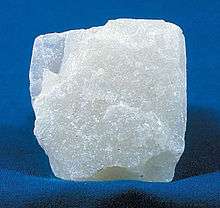Definify.com
Webster 1913 Edition
Talc
Talc
(tălk)
, Noun.
[F.
talc
; cf. Sp. & It. talco
, LL. talcus
; all fr. Ar. talq
.] (Min.)
A soft mineral of a soapy feel and a greenish, whitish, or grayish color, usually occurring in foliated masses. It is hydrous silicate of magnesia.
Steatite
, or soapstone
, is a compact granular variety. Indurated talc
, an impure, slaty talc, with a nearly compact texture, and greater hardness than common talc; – called also
talc slate
.Webster 1828 Edition
Talc
TALC
n. A species of magnesian earth, consisting of broad flat smooth lamins or plates, unctuous to the touch, of a shining luster, translucent, and often transparent. By the action of fire, the lamins open a little, the fragment swells, and the extremities are with difficulty fused into a white enamel. When rubbed with resin, talck acquires positive electricity. Its prevailing colors are white, apple-green and yellow.Of this mineral, Jameson's sixth subspecies of rhomboidal mica, there are two kinds, common and indurated.
Definition 2025
talc
talc
See also: tâlc
English
Noun
talc (plural talcs)

A block of talc.
- (obsolete) Originally a large range of transparent or glistening foliated minerals. Examples include mica, selenite and the hydrated magnesium silicate that the term talc generally has referred to in modern times (see below). Also an item made of such a mineral and depending for its function on the special nature of the mineral (see next). Mediaeval writers adopted the term from the Arabic.[1]
- (obsolete) A microscope slide made of a plate of mica, generally in use from the start of modern microscopy until the early nineteenth century, after which glass slides became the standard medium.[1]
- 1787, George Adams, Essays on the Microscope; containing a Practical Description of the most Improved Microscopes: a General History of Insects, their Transformations, Peculiar Habits, and Œconomy: an Account of the Various Species and Singular Properties of the Hydræ and Vorticellæ: a Description of Three Hundred and Seventy-nine Animalcula; with a Concise Catalogue of Interesting Objects: a View of the Organization of Timber, and the Configuration of Salts when under the Microscope, London: Printed for the author, by Robert Hindmarsh, Printer to His Royal Highness the Prince of Wales, No. 32, Clerkenwell-Close; and sold by the author, at his Shop, Tycho Brahe's Head, No. 60, Fleet-Street, OCLC 745222677, page 7:
- M. [Antonie van] Leeuwenhoek fixed his objects, if they were ſolid, to the foregoing point with glue; if they were fluid, he fitted them on a little plate of talc, or exceeding thin blown glaſs, which he afterwards glued to the needle, in the ſame manner as his other objects.
-
- A soft mineral, composed of hydrated magnesium silicate, that has a soapy feel and a greenish, whitish, or grayish color, and usually occurs in foliated masses.
- 1978, C. J. Parmentier; G. J. Gill, “Practical Aspects of Talc and Asbestos”, in C. C. Gravatt; Philip D. LaFleur; Kurt F. J. Heinrich, editors, Proceedings of Workshop on Asbestos, Definitions and Measurement Methods, page 406:
- With this background and experience we feel justified in stating that not all talcs contain, or are associated with, asbestos.
- 1987, Joseph A. Radosta; Nikhil C. Trivedi, “Talc”, in H. S. Katz; J. V. Mileski, editors, Handbook of Fillers For Plastics, page 217:
- For example, Montana talcs approximate the theoretical composition, while California talcs often contain calcite (CaCO3) and dolomite (CaCO3 • MgCO3).
- 2003, Harutun Karian, Handbook of Polypropylene and Polypropylene Composites, revised & expanded edition, page 573:
- Micronized talcs and, to an even higher degree, submicrometer talcs significantly influence the processing parameters.
-
- Talcum powder.
Translations
soft mineral
Verb
talc (third-person singular simple present talcs, present participle talcing, simple past and past participle talced)
- To apply talc.
- 1940, Rubber Journal, Volume 99, page 479,
- "Generous talcing" is applied not only to the naked bale, but to the inside of the wrapper, and after stenciling, to the interior of the package. This talcing is repeated, "if necessary, dependent upon the number of handlings up to and into stores for steamer loading."
- 1977, Great Britain Health and Safety Executive, Manufacturing & Service Industries, page 43,
- Three manufacturers have now produced separate designs for talcing boxes; one uses conventional techniques of brushing and vibrators, one is a fluidised bed and the third is an electrostatic applicator.
- 1983, Aaron Elkins, The Dark Place, 2010, page 107,
- Then he talced his hands, slipped on a new pair of rubber gloves, went to the shapeless thing at the other end of the table, and began to work.
- 1940, Rubber Journal, Volume 99, page 479,
Translations
See also
French
Etymology
Pronunciation
- IPA(key): /talk/
Noun
talc m (plural talcs)
References
- 1 2 Lesley Brown, editor (1993) The New Shorter Oxford English Dictionary on Historical Principles, 4th edition, Oxford: Clarendon Press, ISBN 978-0-19-861271-1.